Incorporating Uncertainty in Water Resource Management Strategies
VerifiedAdded on 2023/06/15
|7
|2139
|310
Essay
AI Summary
This essay delves into the multifaceted challenges of water resource management (WRM) in the face of environmental uncertainties. It highlights the diverse perspectives on water management, emphasizing its multi-objective nature, and underscores the unpredictable changes in the environment that complicate WRM strategies. The essay identifies various uncertainties, including weather-related factors, land use patterns, and pollution, and explores their implications on water quality and quantity, particularly in the context of climate change and natural calamities. It contrasts deterministic planning with planning under uncertainty, advocating for adaptive strategies that can accommodate unforeseen crises. Furthermore, the essay addresses future challenges in incorporating uncertainty into WRM, such as aligning understanding among stakeholders, ensuring data accuracy, and accounting for unpredictable weather patterns. The conclusion emphasizes the importance of proactive planning and the development of secondary strategies to mitigate the impact of ecological imbalances on water resources, ultimately promoting sustainable water usage.

Running head: UNCERTAINTY AND WATER RESOURCE MANAGEMENT
Uncertainty and Water Resource Management
Name of the Student
Name of the University
Author note
Uncertainty and Water Resource Management
Name of the Student
Name of the University
Author note
Paraphrase This Document
Need a fresh take? Get an instant paraphrase of this document with our AI Paraphraser
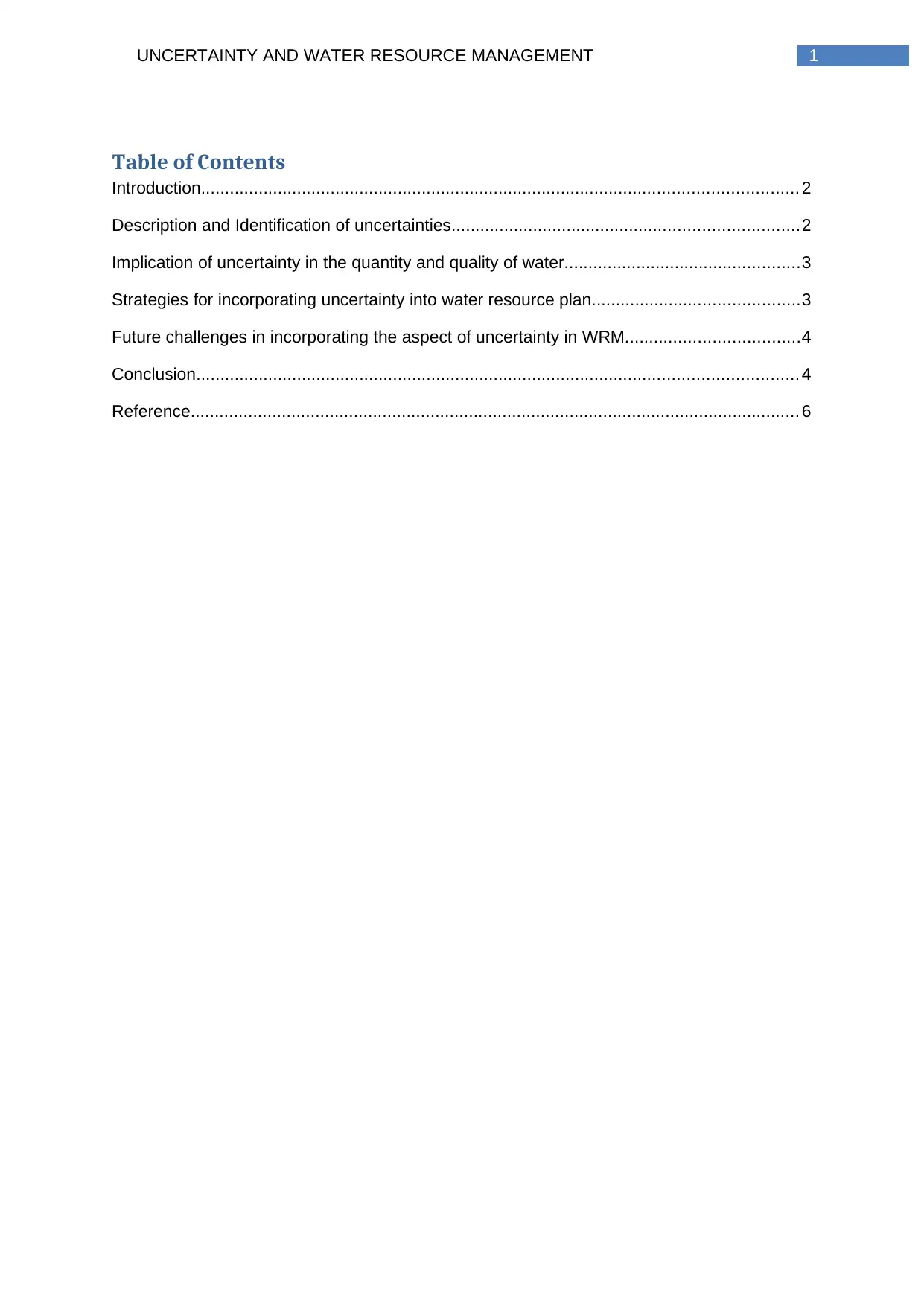
1UNCERTAINTY AND WATER RESOURCE MANAGEMENT
Table of Contents
Introduction............................................................................................................................ 2
Description and Identification of uncertainties........................................................................2
Implication of uncertainty in the quantity and quality of water.................................................3
Strategies for incorporating uncertainty into water resource plan...........................................3
Future challenges in incorporating the aspect of uncertainty in WRM....................................4
Conclusion............................................................................................................................. 4
Reference............................................................................................................................... 6
Table of Contents
Introduction............................................................................................................................ 2
Description and Identification of uncertainties........................................................................2
Implication of uncertainty in the quantity and quality of water.................................................3
Strategies for incorporating uncertainty into water resource plan...........................................3
Future challenges in incorporating the aspect of uncertainty in WRM....................................4
Conclusion............................................................................................................................. 4
Reference............................................................................................................................... 6
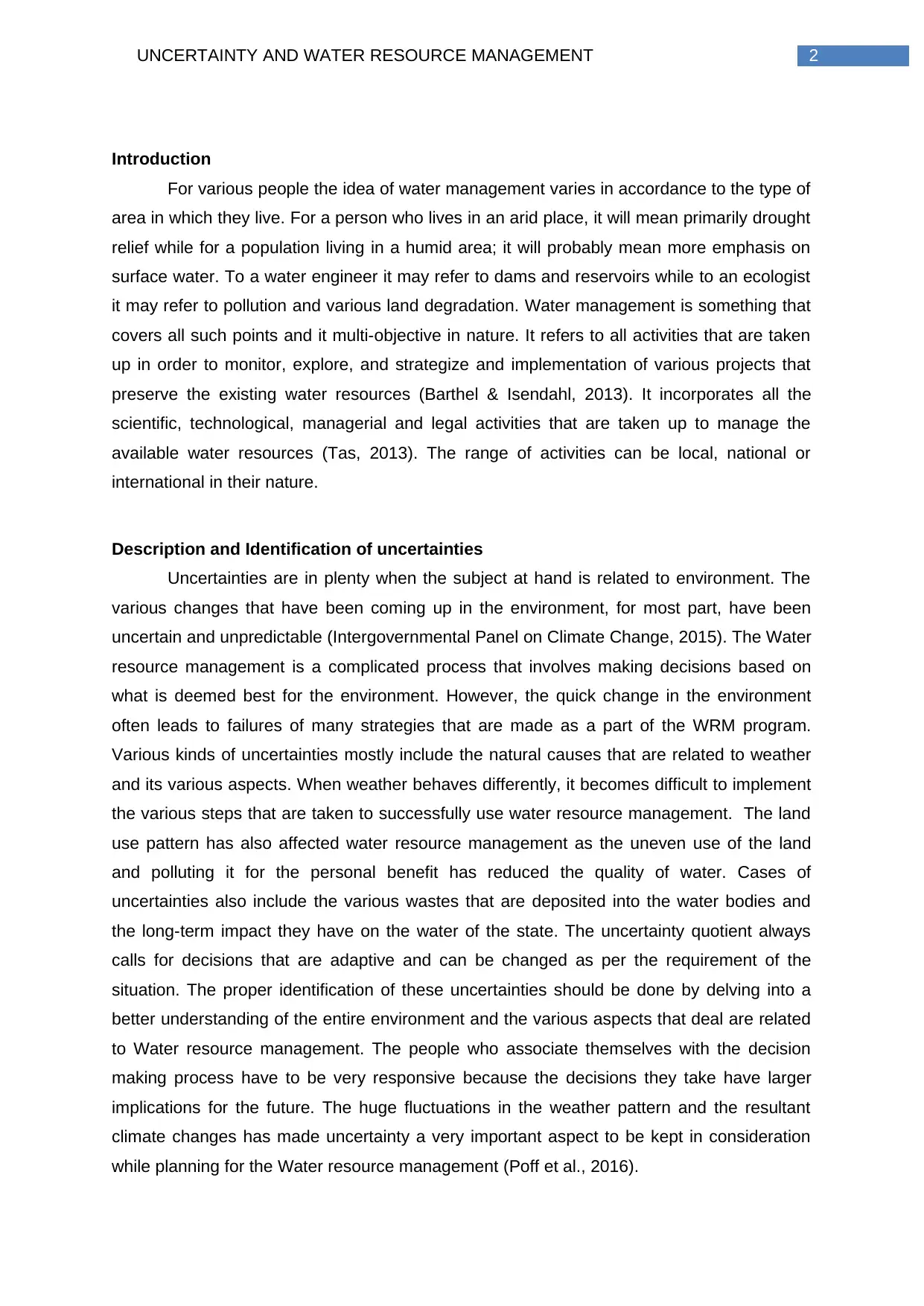
2UNCERTAINTY AND WATER RESOURCE MANAGEMENT
Introduction
For various people the idea of water management varies in accordance to the type of
area in which they live. For a person who lives in an arid place, it will mean primarily drought
relief while for a population living in a humid area; it will probably mean more emphasis on
surface water. To a water engineer it may refer to dams and reservoirs while to an ecologist
it may refer to pollution and various land degradation. Water management is something that
covers all such points and it multi-objective in nature. It refers to all activities that are taken
up in order to monitor, explore, and strategize and implementation of various projects that
preserve the existing water resources (Barthel & Isendahl, 2013). It incorporates all the
scientific, technological, managerial and legal activities that are taken up to manage the
available water resources (Tas, 2013). The range of activities can be local, national or
international in their nature.
Description and Identification of uncertainties
Uncertainties are in plenty when the subject at hand is related to environment. The
various changes that have been coming up in the environment, for most part, have been
uncertain and unpredictable (Intergovernmental Panel on Climate Change, 2015). The Water
resource management is a complicated process that involves making decisions based on
what is deemed best for the environment. However, the quick change in the environment
often leads to failures of many strategies that are made as a part of the WRM program.
Various kinds of uncertainties mostly include the natural causes that are related to weather
and its various aspects. When weather behaves differently, it becomes difficult to implement
the various steps that are taken to successfully use water resource management. The land
use pattern has also affected water resource management as the uneven use of the land
and polluting it for the personal benefit has reduced the quality of water. Cases of
uncertainties also include the various wastes that are deposited into the water bodies and
the long-term impact they have on the water of the state. The uncertainty quotient always
calls for decisions that are adaptive and can be changed as per the requirement of the
situation. The proper identification of these uncertainties should be done by delving into a
better understanding of the entire environment and the various aspects that deal are related
to Water resource management. The people who associate themselves with the decision
making process have to be very responsive because the decisions they take have larger
implications for the future. The huge fluctuations in the weather pattern and the resultant
climate changes has made uncertainty a very important aspect to be kept in consideration
while planning for the Water resource management (Poff et al., 2016).
Introduction
For various people the idea of water management varies in accordance to the type of
area in which they live. For a person who lives in an arid place, it will mean primarily drought
relief while for a population living in a humid area; it will probably mean more emphasis on
surface water. To a water engineer it may refer to dams and reservoirs while to an ecologist
it may refer to pollution and various land degradation. Water management is something that
covers all such points and it multi-objective in nature. It refers to all activities that are taken
up in order to monitor, explore, and strategize and implementation of various projects that
preserve the existing water resources (Barthel & Isendahl, 2013). It incorporates all the
scientific, technological, managerial and legal activities that are taken up to manage the
available water resources (Tas, 2013). The range of activities can be local, national or
international in their nature.
Description and Identification of uncertainties
Uncertainties are in plenty when the subject at hand is related to environment. The
various changes that have been coming up in the environment, for most part, have been
uncertain and unpredictable (Intergovernmental Panel on Climate Change, 2015). The Water
resource management is a complicated process that involves making decisions based on
what is deemed best for the environment. However, the quick change in the environment
often leads to failures of many strategies that are made as a part of the WRM program.
Various kinds of uncertainties mostly include the natural causes that are related to weather
and its various aspects. When weather behaves differently, it becomes difficult to implement
the various steps that are taken to successfully use water resource management. The land
use pattern has also affected water resource management as the uneven use of the land
and polluting it for the personal benefit has reduced the quality of water. Cases of
uncertainties also include the various wastes that are deposited into the water bodies and
the long-term impact they have on the water of the state. The uncertainty quotient always
calls for decisions that are adaptive and can be changed as per the requirement of the
situation. The proper identification of these uncertainties should be done by delving into a
better understanding of the entire environment and the various aspects that deal are related
to Water resource management. The people who associate themselves with the decision
making process have to be very responsive because the decisions they take have larger
implications for the future. The huge fluctuations in the weather pattern and the resultant
climate changes has made uncertainty a very important aspect to be kept in consideration
while planning for the Water resource management (Poff et al., 2016).
⊘ This is a preview!⊘
Do you want full access?
Subscribe today to unlock all pages.

Trusted by 1+ million students worldwide
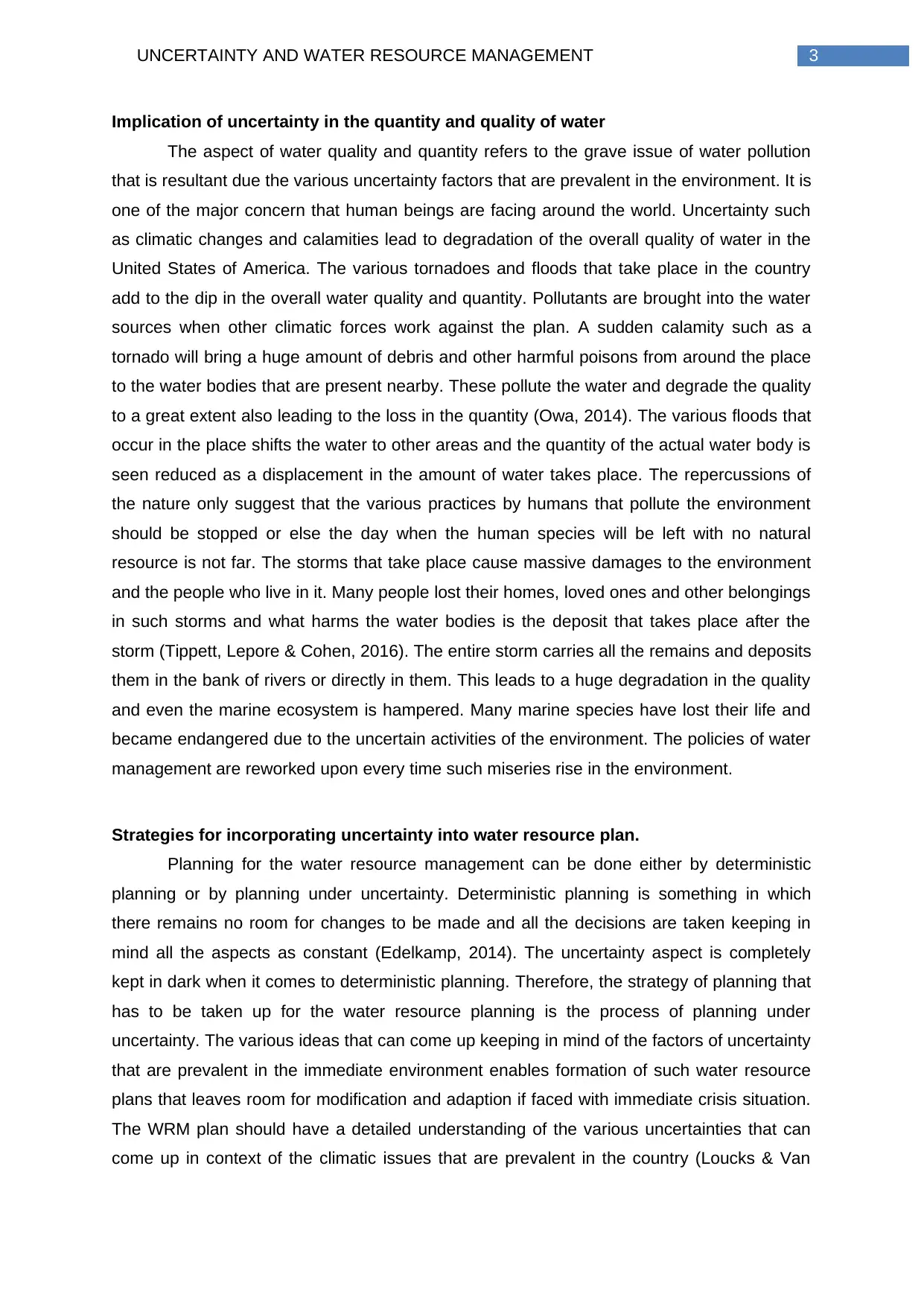
3UNCERTAINTY AND WATER RESOURCE MANAGEMENT
Implication of uncertainty in the quantity and quality of water
The aspect of water quality and quantity refers to the grave issue of water pollution
that is resultant due the various uncertainty factors that are prevalent in the environment. It is
one of the major concern that human beings are facing around the world. Uncertainty such
as climatic changes and calamities lead to degradation of the overall quality of water in the
United States of America. The various tornadoes and floods that take place in the country
add to the dip in the overall water quality and quantity. Pollutants are brought into the water
sources when other climatic forces work against the plan. A sudden calamity such as a
tornado will bring a huge amount of debris and other harmful poisons from around the place
to the water bodies that are present nearby. These pollute the water and degrade the quality
to a great extent also leading to the loss in the quantity (Owa, 2014). The various floods that
occur in the place shifts the water to other areas and the quantity of the actual water body is
seen reduced as a displacement in the amount of water takes place. The repercussions of
the nature only suggest that the various practices by humans that pollute the environment
should be stopped or else the day when the human species will be left with no natural
resource is not far. The storms that take place cause massive damages to the environment
and the people who live in it. Many people lost their homes, loved ones and other belongings
in such storms and what harms the water bodies is the deposit that takes place after the
storm (Tippett, Lepore & Cohen, 2016). The entire storm carries all the remains and deposits
them in the bank of rivers or directly in them. This leads to a huge degradation in the quality
and even the marine ecosystem is hampered. Many marine species have lost their life and
became endangered due to the uncertain activities of the environment. The policies of water
management are reworked upon every time such miseries rise in the environment.
Strategies for incorporating uncertainty into water resource plan.
Planning for the water resource management can be done either by deterministic
planning or by planning under uncertainty. Deterministic planning is something in which
there remains no room for changes to be made and all the decisions are taken keeping in
mind all the aspects as constant (Edelkamp, 2014). The uncertainty aspect is completely
kept in dark when it comes to deterministic planning. Therefore, the strategy of planning that
has to be taken up for the water resource planning is the process of planning under
uncertainty. The various ideas that can come up keeping in mind of the factors of uncertainty
that are prevalent in the immediate environment enables formation of such water resource
plans that leaves room for modification and adaption if faced with immediate crisis situation.
The WRM plan should have a detailed understanding of the various uncertainties that can
come up in context of the climatic issues that are prevalent in the country (Loucks & Van
Implication of uncertainty in the quantity and quality of water
The aspect of water quality and quantity refers to the grave issue of water pollution
that is resultant due the various uncertainty factors that are prevalent in the environment. It is
one of the major concern that human beings are facing around the world. Uncertainty such
as climatic changes and calamities lead to degradation of the overall quality of water in the
United States of America. The various tornadoes and floods that take place in the country
add to the dip in the overall water quality and quantity. Pollutants are brought into the water
sources when other climatic forces work against the plan. A sudden calamity such as a
tornado will bring a huge amount of debris and other harmful poisons from around the place
to the water bodies that are present nearby. These pollute the water and degrade the quality
to a great extent also leading to the loss in the quantity (Owa, 2014). The various floods that
occur in the place shifts the water to other areas and the quantity of the actual water body is
seen reduced as a displacement in the amount of water takes place. The repercussions of
the nature only suggest that the various practices by humans that pollute the environment
should be stopped or else the day when the human species will be left with no natural
resource is not far. The storms that take place cause massive damages to the environment
and the people who live in it. Many people lost their homes, loved ones and other belongings
in such storms and what harms the water bodies is the deposit that takes place after the
storm (Tippett, Lepore & Cohen, 2016). The entire storm carries all the remains and deposits
them in the bank of rivers or directly in them. This leads to a huge degradation in the quality
and even the marine ecosystem is hampered. Many marine species have lost their life and
became endangered due to the uncertain activities of the environment. The policies of water
management are reworked upon every time such miseries rise in the environment.
Strategies for incorporating uncertainty into water resource plan.
Planning for the water resource management can be done either by deterministic
planning or by planning under uncertainty. Deterministic planning is something in which
there remains no room for changes to be made and all the decisions are taken keeping in
mind all the aspects as constant (Edelkamp, 2014). The uncertainty aspect is completely
kept in dark when it comes to deterministic planning. Therefore, the strategy of planning that
has to be taken up for the water resource planning is the process of planning under
uncertainty. The various ideas that can come up keeping in mind of the factors of uncertainty
that are prevalent in the immediate environment enables formation of such water resource
plans that leaves room for modification and adaption if faced with immediate crisis situation.
The WRM plan should have a detailed understanding of the various uncertainties that can
come up in context of the climatic issues that are prevalent in the country (Loucks & Van
Paraphrase This Document
Need a fresh take? Get an instant paraphrase of this document with our AI Paraphraser

4UNCERTAINTY AND WATER RESOURCE MANAGEMENT
Beek, 2017). The authorities should try to create strategies that makes the environment
safer in totality, this will lead to better WRM strategies as if the environment in totality kept in
check then the possibility of an uncertainty shall also reduce substantially. The impact water
has on the state’s agriculture produce is huge and hence it should be always kept in
consideration because a step taken lavishly in WRM planning can lead to a hefty lose to the
agricultural produce of the nation. The ultimate motive has to be plotted down first and then
a set of alternative strategies for the same motive has to be chalked out so that in case of an
uncertainty the best back up plan is always in existence and successfully meets the
requirement of the immediate situation.
Future challenges in incorporating the aspect of uncertainty in WRM.
The challenges that prevail in incorporating the aspect of uncertainty in WRM are
many and it is necessary that all of them have to be worked upon before coming to any
solution for the making of water resource management plan. The biggest challenge that
remains is the aligning of the understanding of problem by all the concerned authorities. The
problems have to be understood in light of the various situations that are analyzed and
worked upon. Only when every authority understands the issue in details, they will be eager
to take a step towards planning a measure that looks after a specific kind of uncertainty. The
uncertainty factor is dependent on the various data that are analyzed to get a better forecast
of the events that can take place in the environment (Refsgaard et al., 2013). The
genuineness of the data is something that will remain a big concern for the management
because these data are completely based on what the satellites provide and hence they
cannot be something that can be blindly trusted upon. The evaluation of their correctness is
necessary so that the various steps that will be taken for the uncertainty factor are aligned to
the forecast that is present with the management. This will allow effective decisions to be
taken and lead to better results for the entire WRM process. The climate is something that
keeps changing regardless of anything else, and it remains one of the most unpredictable
phenomenon that surrounds the topic of uncertainty in respect to Water resource
management. The challenge lies in the fact that weather and its trends can change anytime
and hence any formulated plan can be beaten if the weather plays a foul game. The
planning will need to have multiple options to move to in case of any such change in the
weather that was not forecasted or predicted previously (Benson et al., 2014).
Conclusion
The idea of having possible methods to fight uncertainties in the context of WRM is
very relevant in this era of ecological imbalances. The massive impact of every activity that
Beek, 2017). The authorities should try to create strategies that makes the environment
safer in totality, this will lead to better WRM strategies as if the environment in totality kept in
check then the possibility of an uncertainty shall also reduce substantially. The impact water
has on the state’s agriculture produce is huge and hence it should be always kept in
consideration because a step taken lavishly in WRM planning can lead to a hefty lose to the
agricultural produce of the nation. The ultimate motive has to be plotted down first and then
a set of alternative strategies for the same motive has to be chalked out so that in case of an
uncertainty the best back up plan is always in existence and successfully meets the
requirement of the immediate situation.
Future challenges in incorporating the aspect of uncertainty in WRM.
The challenges that prevail in incorporating the aspect of uncertainty in WRM are
many and it is necessary that all of them have to be worked upon before coming to any
solution for the making of water resource management plan. The biggest challenge that
remains is the aligning of the understanding of problem by all the concerned authorities. The
problems have to be understood in light of the various situations that are analyzed and
worked upon. Only when every authority understands the issue in details, they will be eager
to take a step towards planning a measure that looks after a specific kind of uncertainty. The
uncertainty factor is dependent on the various data that are analyzed to get a better forecast
of the events that can take place in the environment (Refsgaard et al., 2013). The
genuineness of the data is something that will remain a big concern for the management
because these data are completely based on what the satellites provide and hence they
cannot be something that can be blindly trusted upon. The evaluation of their correctness is
necessary so that the various steps that will be taken for the uncertainty factor are aligned to
the forecast that is present with the management. This will allow effective decisions to be
taken and lead to better results for the entire WRM process. The climate is something that
keeps changing regardless of anything else, and it remains one of the most unpredictable
phenomenon that surrounds the topic of uncertainty in respect to Water resource
management. The challenge lies in the fact that weather and its trends can change anytime
and hence any formulated plan can be beaten if the weather plays a foul game. The
planning will need to have multiple options to move to in case of any such change in the
weather that was not forecasted or predicted previously (Benson et al., 2014).
Conclusion
The idea of having possible methods to fight uncertainties in the context of WRM is
very relevant in this era of ecological imbalances. The massive impact of every activity that
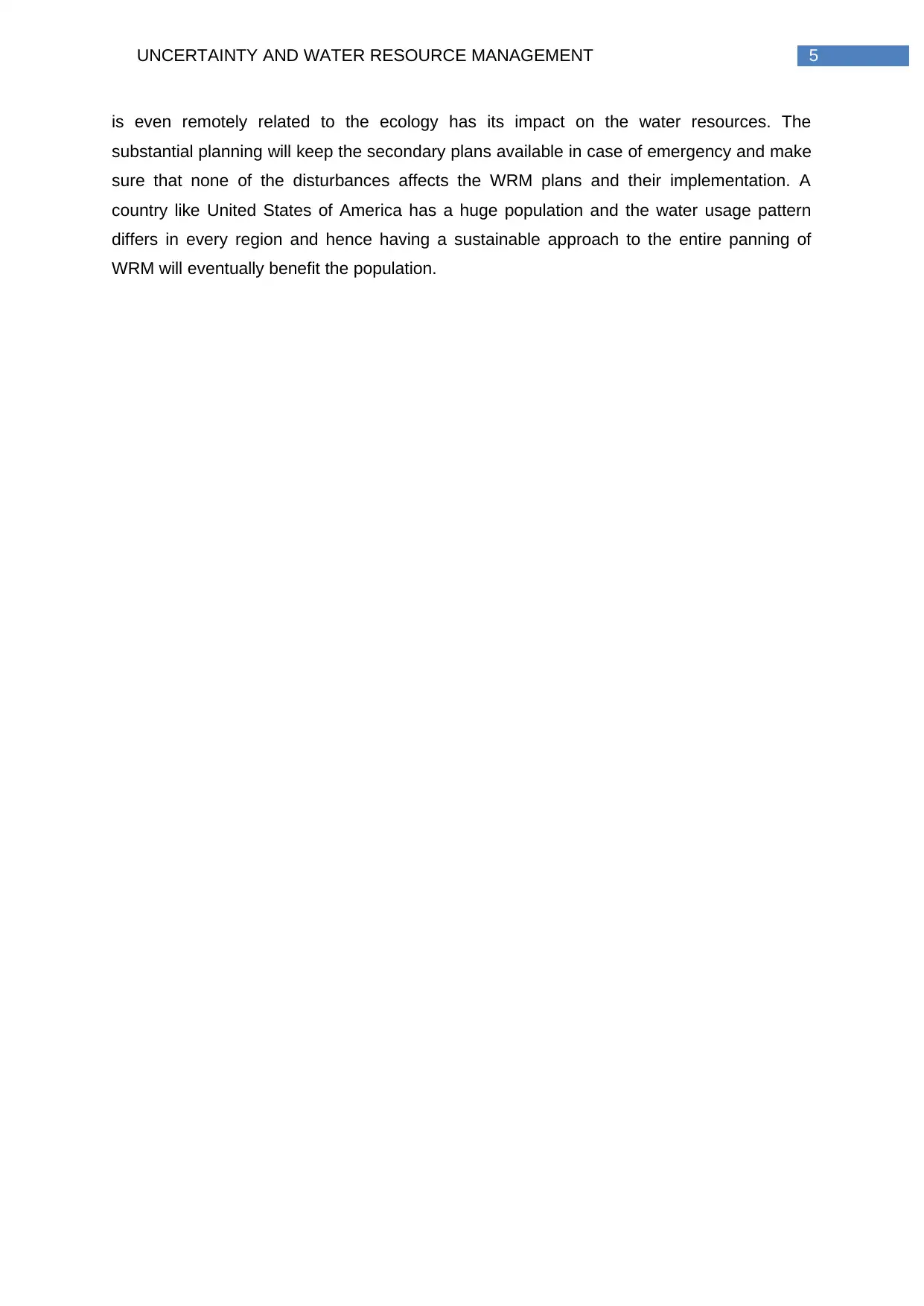
5UNCERTAINTY AND WATER RESOURCE MANAGEMENT
is even remotely related to the ecology has its impact on the water resources. The
substantial planning will keep the secondary plans available in case of emergency and make
sure that none of the disturbances affects the WRM plans and their implementation. A
country like United States of America has a huge population and the water usage pattern
differs in every region and hence having a sustainable approach to the entire panning of
WRM will eventually benefit the population.
is even remotely related to the ecology has its impact on the water resources. The
substantial planning will keep the secondary plans available in case of emergency and make
sure that none of the disturbances affects the WRM plans and their implementation. A
country like United States of America has a huge population and the water usage pattern
differs in every region and hence having a sustainable approach to the entire panning of
WRM will eventually benefit the population.
⊘ This is a preview!⊘
Do you want full access?
Subscribe today to unlock all pages.

Trusted by 1+ million students worldwide
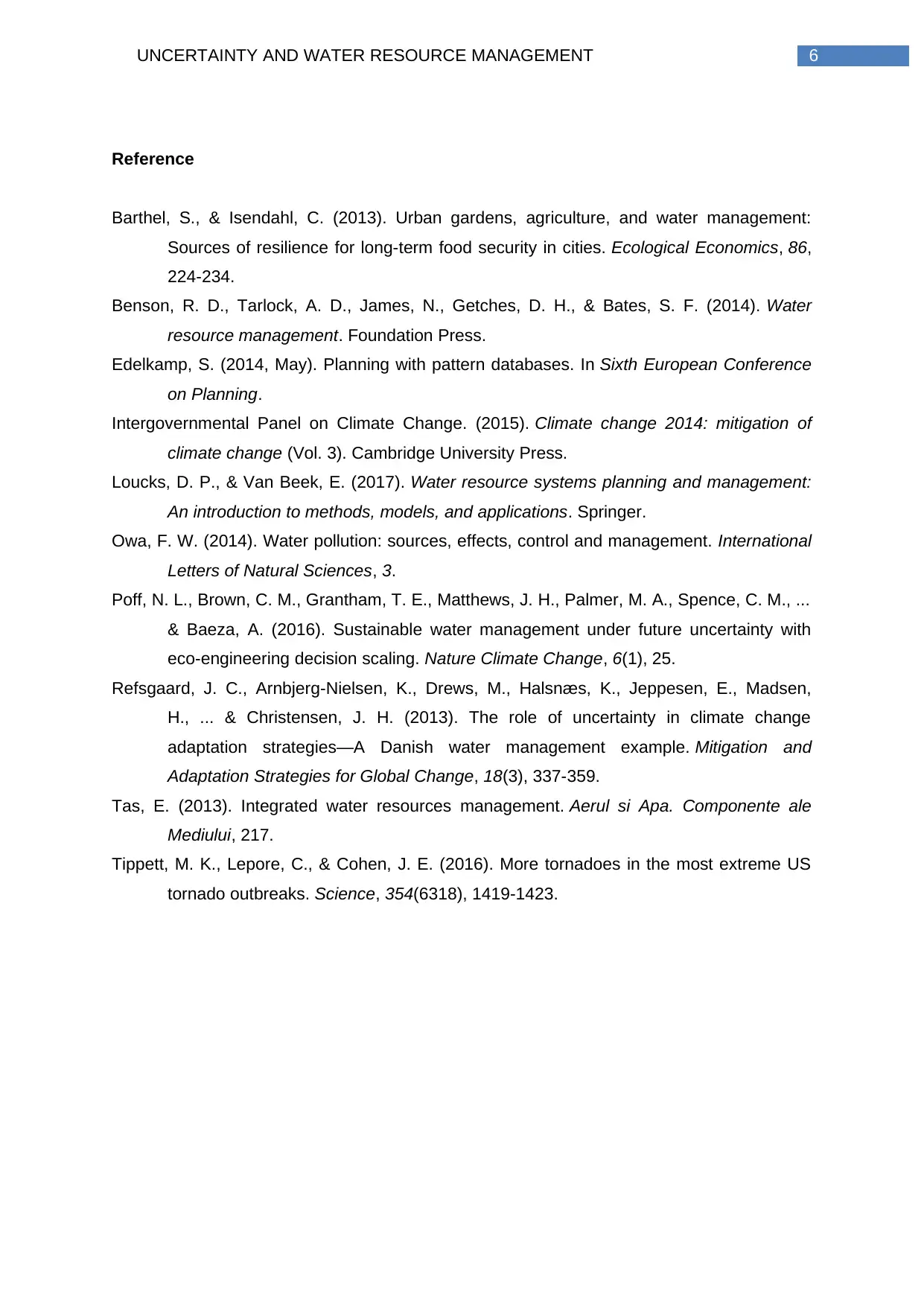
6UNCERTAINTY AND WATER RESOURCE MANAGEMENT
Reference
Barthel, S., & Isendahl, C. (2013). Urban gardens, agriculture, and water management:
Sources of resilience for long-term food security in cities. Ecological Economics, 86,
224-234.
Benson, R. D., Tarlock, A. D., James, N., Getches, D. H., & Bates, S. F. (2014). Water
resource management. Foundation Press.
Edelkamp, S. (2014, May). Planning with pattern databases. In Sixth European Conference
on Planning.
Intergovernmental Panel on Climate Change. (2015). Climate change 2014: mitigation of
climate change (Vol. 3). Cambridge University Press.
Loucks, D. P., & Van Beek, E. (2017). Water resource systems planning and management:
An introduction to methods, models, and applications. Springer.
Owa, F. W. (2014). Water pollution: sources, effects, control and management. International
Letters of Natural Sciences, 3.
Poff, N. L., Brown, C. M., Grantham, T. E., Matthews, J. H., Palmer, M. A., Spence, C. M., ...
& Baeza, A. (2016). Sustainable water management under future uncertainty with
eco-engineering decision scaling. Nature Climate Change, 6(1), 25.
Refsgaard, J. C., Arnbjerg-Nielsen, K., Drews, M., Halsnæs, K., Jeppesen, E., Madsen,
H., ... & Christensen, J. H. (2013). The role of uncertainty in climate change
adaptation strategies—A Danish water management example. Mitigation and
Adaptation Strategies for Global Change, 18(3), 337-359.
Tas, E. (2013). Integrated water resources management. Aerul si Apa. Componente ale
Mediului, 217.
Tippett, M. K., Lepore, C., & Cohen, J. E. (2016). More tornadoes in the most extreme US
tornado outbreaks. Science, 354(6318), 1419-1423.
Reference
Barthel, S., & Isendahl, C. (2013). Urban gardens, agriculture, and water management:
Sources of resilience for long-term food security in cities. Ecological Economics, 86,
224-234.
Benson, R. D., Tarlock, A. D., James, N., Getches, D. H., & Bates, S. F. (2014). Water
resource management. Foundation Press.
Edelkamp, S. (2014, May). Planning with pattern databases. In Sixth European Conference
on Planning.
Intergovernmental Panel on Climate Change. (2015). Climate change 2014: mitigation of
climate change (Vol. 3). Cambridge University Press.
Loucks, D. P., & Van Beek, E. (2017). Water resource systems planning and management:
An introduction to methods, models, and applications. Springer.
Owa, F. W. (2014). Water pollution: sources, effects, control and management. International
Letters of Natural Sciences, 3.
Poff, N. L., Brown, C. M., Grantham, T. E., Matthews, J. H., Palmer, M. A., Spence, C. M., ...
& Baeza, A. (2016). Sustainable water management under future uncertainty with
eco-engineering decision scaling. Nature Climate Change, 6(1), 25.
Refsgaard, J. C., Arnbjerg-Nielsen, K., Drews, M., Halsnæs, K., Jeppesen, E., Madsen,
H., ... & Christensen, J. H. (2013). The role of uncertainty in climate change
adaptation strategies—A Danish water management example. Mitigation and
Adaptation Strategies for Global Change, 18(3), 337-359.
Tas, E. (2013). Integrated water resources management. Aerul si Apa. Componente ale
Mediului, 217.
Tippett, M. K., Lepore, C., & Cohen, J. E. (2016). More tornadoes in the most extreme US
tornado outbreaks. Science, 354(6318), 1419-1423.
1 out of 7
Related Documents
Your All-in-One AI-Powered Toolkit for Academic Success.
+13062052269
info@desklib.com
Available 24*7 on WhatsApp / Email
![[object Object]](/_next/static/media/star-bottom.7253800d.svg)
Unlock your academic potential
Copyright © 2020–2025 A2Z Services. All Rights Reserved. Developed and managed by ZUCOL.





